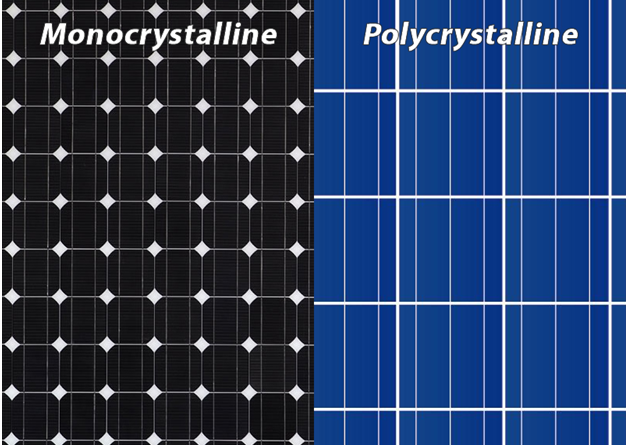One of the question clients like to ask when shopping for solar panel is “between Monocrystalline and Polycrystalline solar panels which should i get?” well today we will look into this.
According to Energy Sage, both monocrystalline and polycrystalline solar panels are built to serve the same function in the overall solar PV system: they capture energy from the sun and turn it into electricity. They are also both made from silicon, which is used for solar panels because it is an abundant, very durable element. Many solar panel manufacturers produce both monocrystalline and polycrystalline panels.
Both monocrystalline and polycrystalline solar panels can be good choices for your home, but there are key differences between the two types of technology that you should understand before making your final solar purchase decision. The main difference between the two technologies is the type of silicon solar cell they use: monocrystalline solar panels have solar cells made from a single crystal of silicon, while polycrystalline solar panels have solar cells made from many silicon fragments melted together.
Monocrystalline solar panels
Monocrystalline solar panels are generally thought of as a premium solar product. The main advantages of moncrystalline panels are higher efficiencies and sleeker aesthetics. Mono solar panels have the highest efficiency rate (between 15%-20%);
To make solar cells for monocrystalline solar panels, silicon is formed into bars and cut into wafers. These types of panels are called “monocrystalline” to indicate that the silicon used is single-crystal silicon. Because the cell is composed of a single crystal, the electrons that generate a flow of electricity have more room to move. As a result, monocrystalline panels are more efficient than their polycrystalline counterparts.
Polycrystalline solar panels
Polycrystalline solar panels generally have lower efficiencies than monocrystalline options, but their advantage is slightly lower prices.
Polycrystalline solar panels are also made from silicon. However, instead of using a single crystal of silicon, manufacturers melt many fragments of silicon together to form the wafers for the panel. Polycrystalline solar panels are also referred to as “multi-crystalline,” or many-crystal silicon. Because there are many crystals in each cell, there is less freedom for the electrons to move. As a result, polycrystalline solar panels have lower efficiency ratings than monocrystalline panels.
Pscsolaruk enumerated the adavantages and disadvantages of Mono and Poly panel Thus
Advantages and Disadvantages of Monocrystalline Solar Panels Modules
Advantages:
- Mono solar panels have the highest efficiency rate (usually around 15%-20%);
- Monocrystalline modules are space-efficient. Because these modules deliver the highest power output, they require the least amount of space comparing to other solar panels;
- Mono solar panels have a long lifespan – most manufacturers offer a 25-year warranty on their mono solar panels;
- They perform better than other types of solar modules in low-light conditions.
Disadvantages:
- Monocrystalline modules are the most expensive;
- If they are covered with dirt, the entire system may be affected;
Advantages and Disadvantages of Polycrystalline Solar Panels Modules
Advantages:
- The process used to manufacture poly solar panels is simpler and, thus, less pricey.
- They usually have a lower heat tolerance than monocrystalline modules.
Disadvantages:
- Because the silicon purity is lower than mono modules, poly solar panels are less efficient than their mono counterparts. Their efficiency is usually rated at around 13%-16%.
- Not only that they are less energy efficient, but they have a low space efficacy as well. You need to cover a larger surface to get the same power as you would with monocrystalline modules.
Which One Should I Choose?
The larger and purer the crystal is, the more efficient the solar cells will be. As a result, monocrystalline modules are around 10% to 15% more energy efficient than their poly counterparts. Click to see our mono panels available
Polycrystalline modules, on the other hand, were often thought to be inferior to mono solar panels because they are less efficient. But, here’s the catch: because of the cheaper process, it costs around 20% less to create solar modules with monocrystalline structures. More than that, poly modules have been improving their performance constantly in recent years, pushing the standard to greater limits.

